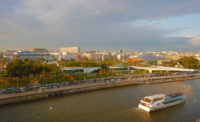Vladislav Kirpichev believes that all children are creative geniuses. For 40 years, he and his wife, Liudmila, have been proving it at EDAS—the Experimental Children’s Architectural Studio, in Moscow. Kids as young as 2 come to the Kirpichevs’ classes to learn about the basics of architecture—form, space, rhythm, texture, color. With their enthusiasm, the Kirpichevs have not only inspired several thousand Muscovite youngsters to paint, draw, and build models, but they have won a long list of admirers in the grown-up architecture world. “It’s a rare and beautiful thing,” says architect Steven Holl, who has been observing EDAS classes for at least 20 years. Calling it a “miniature Black Mountain College,” referring to the legendary progressive arts institution, Holl says the work that comes out of EDAS is extraordinary: “I’m not exaggerating. It’s as good as many first-year architecture studios.”
The key to the children’s talents, Liudmila says, is that they are “more anarchistic” than grown-ups. “The smaller ones are less limited by obligations. They don’t know the correct answers to the questions. That’s why their work is never boring.”
The program was begun in the Soviet era, which may explain why Vladislav has called education in Russia “child abuse.” Liudmila and he, both of them architects, presented an alternative, which flourished despite political repression. “Creative people always find a way, no matter what,” says Liudmila. These days, she says, EDAS is thriving, because of the country’s relative openness. Some students come once a week for classes at the studio, others several times.
The school is run for profit. “People in the know in Moscow send their sons and daughters to this class,” says Holl. Many are wealthy. But there are also students who can’t afford to pay, and don’t, Liudmila said by phone from Frankfurt, where the couple had taken a group of youngsters to see buildings by Coop Himmelblau, Frank Gehry, Richard Meier, and others. (They will also make a school trip to the Venice Architecture Biennale this summer.)
The Kirpichevs plan to publish a book, as early as this fall, documenting 40 years of student work at EDAS. The book, they say, will contain thousands of images.
Greg Lynn, the Los Angeles–based architect and theorist, has participated in EDAS classes in Moscow and during the Kirpichevs’ occasional visits to the U.S. He calls the couple amazing: “They get kids thinking about transportation, energy, landscape, and urban living, all through drawings, paintings, and room-scale models, and then they have international architects and urbanists come in and talk to them about it. It is as inspiring for the architects as it is for the kids.”










Post a comment to this article
Report Abusive Comment